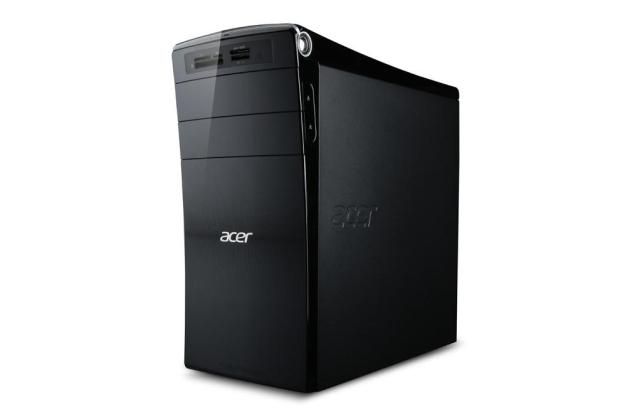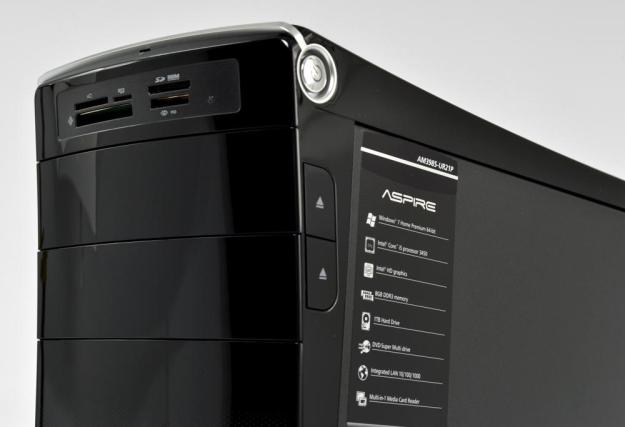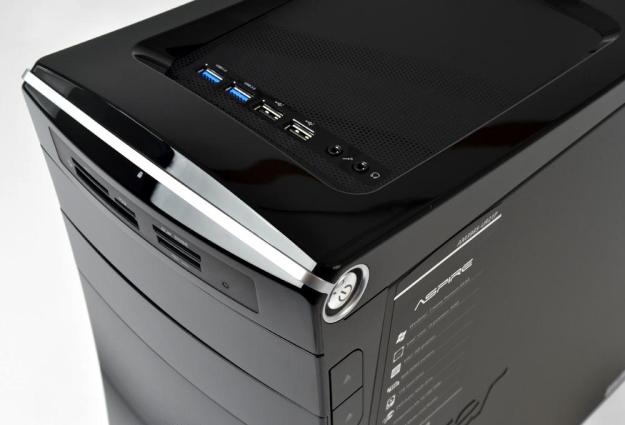
“The M3985 is a simple, competent PC. It provides enough power for many users, it’s silent and it has no serious flaws.”
- Attractive enclosure
- Plenty of connectivity
- Lots of RAM and large hard drive
- Inexpensive
- Terrible 3D performance
- Poorly located power and optical drive buttons
Desktop manufacturers have been gradually updating their products in wake of Ivy Bridge’s release. Intel’s new processors have bigger numbers than the old ones, after all. However, because these are desktops and not laptops, designers have no particular reason to heavily update the surrounding chassis.
Such is the case with the Acer Aspire M3985. It’s instantly recognizable as an Acer computer from the outside. Inside, however, it has an Intel Core i5-3450 processor. This quad-core, mid-range part is smack dab in the middle of Intel’s line, and the same can be said of the M3985. North American availability of the Acer M3985 appears limited at this time, but the few online retailers stocking it are listing a price of $699.

The third-generation processor is supported by 8GB of DDR3 memory and 1TB of hard disk storage. Discrete graphics were omitted in our review unit, so this desktop has to get by with Intel HD 2500, the least powerful integrated graphics processor (IGP) available on Intel’s new parts.
We’ve been hearing about Intel’s latest processors for some time now, so they may seem like old news. But because the major manufacturers have been slow to include the third-gen parts in budget desktops, Acer is ahead of the competition in this area. Let’s see if the new processor – or anything else – separates the M3985 from the crowd.
Still ship-shape
The M3985’s exterior has changed little, if at all, relative to the M3970 we reviewed earlier in 2012. It has the same plastic-and-metal case that is reminiscent of a tall container ship. The front and top of the case reach a silver-trimmed point along the laptop’s forward edge. We don’t think this design is gorgeous, but it’s attractive, particularly for an inexpensive desktop.

The size is also reasonable. At 16.5 inches tall and 15 inches deep, it will fit in, under or beside most desks – with room to spare.
One problem that carries over from the M3970 isthe position of the tower’s power and optical drive eject buttons. They’re on the right flank near the front, which is great if you position the desktop to your left but annoying if you position it on your right. Not everyone has a choice in this matter because many computer desks include an unmovable built-in cabinet.

We were puzzled to find that Acer includes buttons for both drive bays even when only one is filled. It’s simple cost cutting, and most manufacturers have similar issues, but that doesn’t mean a lack of attention to detail is OK.
Good connectivity, so-so placement
The M3985’s forward connectivity includes two USB 3.0 ports, two USB 2.0 ports and individual headphone and microphone jacks. This competitive array of ports is an upgrade over the previous model. However, the ports are still located on top of the case, lurking a few inches behind the computer’s bow. Users who place their computer inside a desk cabinet will find the port placement inconvenient.
Rear connectivity is good with a pair of PS/2 keyboard and mouse ports, HDMI, VGA, two additional USB 3.0 ports and four additional USB 2.0 ports. The standard trio of audio jacks also makes an appearance. We would like to see a DVI port, but that’s unusual among desktops which rely on Intel HD graphics. Otherwise, we have no complaints.

A card reader also appears on the front of the desktop. The card slots are not hidden by a body panel, which we prefer. Card reader slots are barely noticeable on a black chassis such as this.
Software and extras
We were annoyed when Acer displayed trial ads for not just one but two anti-virus suites – Norton and McAfee – when we first booted the system. Running two anti-virus suites at the same time without causing conflicts is nearly impossible, so no reason exists for both to appear.
Otherwise, bloatware is typical for an Acer system. The company loves to add Web service shortcuts to the desktop. The shortcuts effectively work as small advertisements but, because they are merely shortcuts, you can quickly delete them.

A keyboard and mouse were included with the desktop. Both were wired and extremely basic. Many users will want to replace the keyboard, which features a strange island-style layout that looks like a dust trap and provides little tactile feel. The mouse is adequate. We would want to upgrade, but the average user probably can get by the standard issue.
Intel wins and loses
This new desktop comes with the new Intel Core i5-3450 processor with a base clock of 3.1GHz. It is a third-generation quad-core. Like the previous generation Core i5, this product includes Turbo Boost (up to 3.5GHz) but includes no hyper-threading.
The performance improvement over the previous M3970 is modest. In SiSoft Sandra’s Processor Arithmetic benchmark, the M3970’s second-generation Core i5-2320 reached a score of 59 GOPS. The M3985 reached 63.8 GOPS — an improvement, but a small one. File archiver 7-Zip reported the same, offering a combined score of 14,480.
PCMark 7 saw a substantial increase in its score, which reached 3,355. That’s on par with other mid-range desktops and all-in-one systems such as the HP Omni 27 and HP Pavilion HPE h9. The total score the M3985 achieved was from strong showings across the board rather than from a particularly high score in a single area.
The desktop’s minor performance improvement over the last generation was a downer, but Intel’s HD 2500 graphics solution is a serious disappointment. It achieved a score of 4,160 in 3DMark 06 and 412P in 3DMark 11. Both scores are the lowest we’ve recorded in nearly two years. Intel HD 2500 can play older game titles at acceptable frame rates, but it clearly is inadequate for modern games.
Silence prevails
Silence is the greatest benefit to Intel’s integrated graphics. Discrete graphics cards are still among the loudest components in a modern computer. Even less powerful cards are often noisy because they use small fans spinning at high speeds. You’ll hear no such noise coming from this Acer.
In fact, you probably won’t hear much of anything. We could only detect the system’s fan when we turned off all fans, computers and other peripherals in the room in which we tested the Acer. And that’s at load with the system about 5 feet away. In most situations, the computer will seem silent because ambient noise overpowers the system fan.
Conclusion
We’ve been wondering why manufacturers have been slow to roll out Intel’s new third-generation processors in mid-range towers. Now the issue seems clearer. The addition of the Intel Core i5-3450 to this system, which in all other respects is nearly identical to the Acer Aspire M3970 we reviewed earlier this year, improves little. The performance gap is tiny.
The Intel HD 2500 is nothing to brag about, either. We can’t help but wonder why Intel has decided to use this instead of providing the Intel HD 4000 to all of its desktop parts. Intel already does this for its laptop products, which is why an Ultrabook can beat this desktop in 3DMark. The decision to handicap mainstream processors with a slow IGP brings back memories of the infamous Graphics Media Accelerator, a part that didn’t deserve its name. All mainstream desktops, however, share these problems, so we can’t single out this Acer because of them. The M3985 is a simple, competent PC. It provides enough power for many users, it’s silent and it has no serious flaws. Pricing also appears competitive, though this may change as other manufacturers introduce more third-generation desktops and jostle for position. We see no particular reason to buy this desktop but no particular reason not to.
Highs
- Attractive enclosure
- Plenty of connectivity
- Lots of RAM and large hard drive
- Inexpensive
Lows
- Terrible 3D performance
- Poorly located power and optical drive buttons
Editors' Recommendations
- Why Apple’s M3 Ultra could be an absolute monster
- The MacBook Pro M3 doesn’t have a memory problem — it has a pricing problem
- Apple’s M3 Max appears to keep up with Intel’s top desktop CPU
- Apple’s new M3 Pro might come with an unexpected downgrade
- Why the MacBook Air is still stuck on the M2


